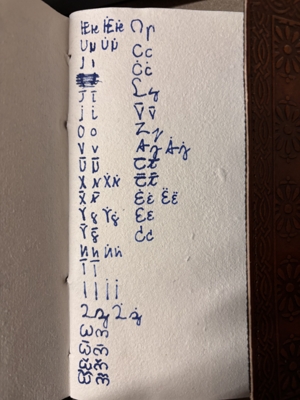A Centralized Alphabet
I have recently (as of 26 oct. 2025) now changed the alphabets of Ektari Tai, Anshens (every dialect; Uhpyurih Anshens, Gajalaoih Anshens, and Shuagekih Anshens), and Khati such that they all now have the same alphabet and will have the same romanizations, both of which I will put below (the alphabet proper will be in photo form for now). Due to some variation in phonolgy, there are some additional characters added and removed or slight changes in pronounciations from the main alphabet and its base pronounciations on a language-by-language basis; I will mark this as it comes. Note that the romanization here is mainly focussed on the approximate Anshens and Ektari pronounciations, this was done because they're the two primary languages and the only other language to use the alphabet, Khati, uses the same pronounciations as Anshens

| RWSPC | RNSPC | IPA (Anshens) | IPA (Ektari) |
|---|---|---|---|
| E, e | E, e | [ɛ] | [ɛ] |
| A, a | A, a | [a] | [a] |
| İ, i | I, i | [i] | [i] |
| I, ı | Ih, ih | [ɪ] | [ɪ] |
| Î, î | Iy, iy | n/a | [ɨ] |
| O, o | O, o | [o] | [o] |
| U, u | U, u | [u] | [u] |
| Ū, ū | Uh, uh | [ʌ] | [ʌ] |
| K, k | K, k | [k] | [c] |
| C, c | C, c | n/a | [ɟ] |
| P, p | P, p | [p] | n/a |
| B, b | B, b | [b]* | [b] |
| G, g | G, g | [g] | [ʁ] |
| D, d | D, d | [d] | [d] |
| T, t | T, t | [t] | [t] |
| L, l | L, l | [l] | [l] |
| M, m | M, m | [m] | [m] |
| N, n | N, n | [n] | [n] |
| Ņ, ņ | Ng, ng | [ŋ] | n/a |
| Mn, mn | Mn, mn | [mn] | n/a |
| R, r | R, r | [r] | [ɾ] |
| S, s | S, s | [s] | [s] |
| Ś, ś | Ts, ts | [t͡s] | [t͡s] |
| Z, z | Z, z | [z] | [d͡z] |
| V, v | V, v | [v] | [v] |
| F, f | F, f | [f] | n/a |
| J, j | J, j | [ʒ] | [ʒ] |
| Þ, þ | Th, th | [θ] | n/a |
| Ð, ð | Dh, dh | [ð] | [ð] |
| Ş, ş | Ch, ch | [t͡ʃ] | [t͡ʃ] |
| Š, š | Sh, sh | [ʃ] | [ʃ] |
| Y, y | Y, y | [j] | [ij], [ji] |
*Not in Gajalaoih Anshens
Extra Characters
To accomodate the other languages as well as some extra phones, there are two diacritics that can be added to a letter to change its sound. In the alphabet proper, they are realized as a macron and a dot, the macron is used to 'soften' a sound, and the dot is used to 'harden' it. In the romanization, those letters with macrons are expressed as separate letters, while those with a dot are often written as the based letter with an 'h' after it (i. e. 'eh'). There are exceptions to this in the letters 'iy', 'ts', and 'ch'; but this was done due for readability and consistency, as 'iy' and 'ts' would've interfered with the non-spec romanizations of 'ih' and 'sh', and 'ch' would've been 'shh' and to be frank it just would look bad.
Dotted letters in Anshens*:
| Letter | IPA |
|---|---|
| Eh, eh | [e] |
| Ah, ah | [ɐ]* |
| Gh, gh, Ġ, ġ | [x] |
| Jh, jh | [d͡ʒ]** |
Dotted letters in Khati are:
| Letter | IPA |
|---|---|
| Eh, eh | [e] |
| Ah, ah | [a]*** |
| Kh, kh | [k'] |
| Ph, ph | [p'] |
| Gh, gh, Ġ, ġ | [ʁ] |
| Th, th | [t'] |
| Lh, lh | [e] |
| Chh, chh, Şh, şh | [t͡ʃ'] |
*Uhpyurih Anshens is the only dialect to use this
**Shuagekih Anshens is the only dialect to use this
***In Khati, 'a' makes a [ɐ] sound
There are still some more differences to go over; in the Shuagekih dialect of Anshens and Khati, the letter 'p' is given a macron to indicate that it is pronounced as [b] (as opposed to in the Uhpyurih and Gachalaoih dialects of Anshens wherein its pronounciation floats between [p] and [b]), and as such in the romanization, [p] is written as 'p', and [b] is written as 'b'.
As well, only dialects of Anshens use the letters 'mn' and 'ng'
